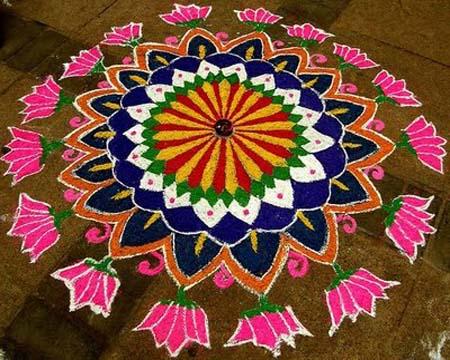What is Rangoli?
Rangoli, pronounced as “Rang-o-lee,” is an ancient art form from India that involves creating intricate patterns on the ground using colored powders, rice flour, or colored sand. This beautiful tradition is deeply rooted in Indian culture and is often used to celebrate festivals, weddings, and other special occasions.
The Origin of Rangoli
The origins of Rangoli can be traced back to ancient Indian civilizations, with evidence of this art form found in the Vedas, one of the oldest sacred texts in Hinduism. Initially, Rangoli was created at the entrance of homes or temples to ward off evil spirits and invite positive energy. Over time, it has become a symbol of joy, prosperity, and good luck, and is now a cherished part of Indian culture.

Materials and Tools Used in Rangoli
Creating a Rangoli requires specific materials and tools. The most common materials used are colored rice flour, colored sand, and dry flour. Other materials include colored powders, flowers, leaves, and even flowers. Tools used for creating Rangoli include a rangoli cone, a rangoli brush, and a rangoli comb. These tools help in creating intricate patterns and designs.
Types of Rangoli Patterns
Rangoli patterns can vary greatly depending on the occasion, region, and the creator’s imagination. Some popular types of Rangoli patterns include:
| Pattern Type | Description |
|---|---|
| Floral Patterns | These patterns are inspired by flowers and plants, and often include intricate designs of leaves, petals, and stems. |
| Geometric Patterns | Geometric patterns are made up of shapes like circles, squares, triangles, and diamonds, and are often used to create symmetrical designs. |
| Animal Patterns | Animal patterns include representations of various animals, such as elephants, peacocks, and tigers, and are often used to symbolize strength and prosperity. |
| Abstract Patterns | Abstract patterns are free-form designs that do not necessarily represent any specific object or animal, and are often used to showcase the artist’s creativity. |
The Significance of Rangoli
Rangoli is not just an art form; it is a reflection of Indian culture, beliefs, and traditions. It is a way to express joy, welcome guests, and celebrate special occasions. Rangoli is also believed to bring good luck and prosperity to the household. In many Indian homes, Rangoli is created on important days like Diwali, Holi, and wedding ceremonies.
Creating Your Own Rangoli
Creating your own Rangoli is a fun and rewarding activity. Here are some tips to help you get started:
- Choose a flat, clean surface to create your Rangoli on.
- Plan your design and sketch it out on paper before starting.
- Start by creating the outline of your design using a rangoli cone or a brush.
- Fill in the colors using colored powders or rice flour.
- Use a rangoli comb to create smooth lines and patterns.
Conclusion
Rangoli is a beautiful and unique art form that reflects the rich cultural heritage of India. Whether you are creating a Rangoli for a festival or just for fun, it is a great way to express your creativity and connect with Indian culture.

